Attached files
| file | filename |
|---|---|
| EX-99.1 - EX-99.1 - LCI INDUSTRIES | lcii2021q1results.htm |
| 8-K - 8-K - LCI INDUSTRIES | lcii-20210504.htm |
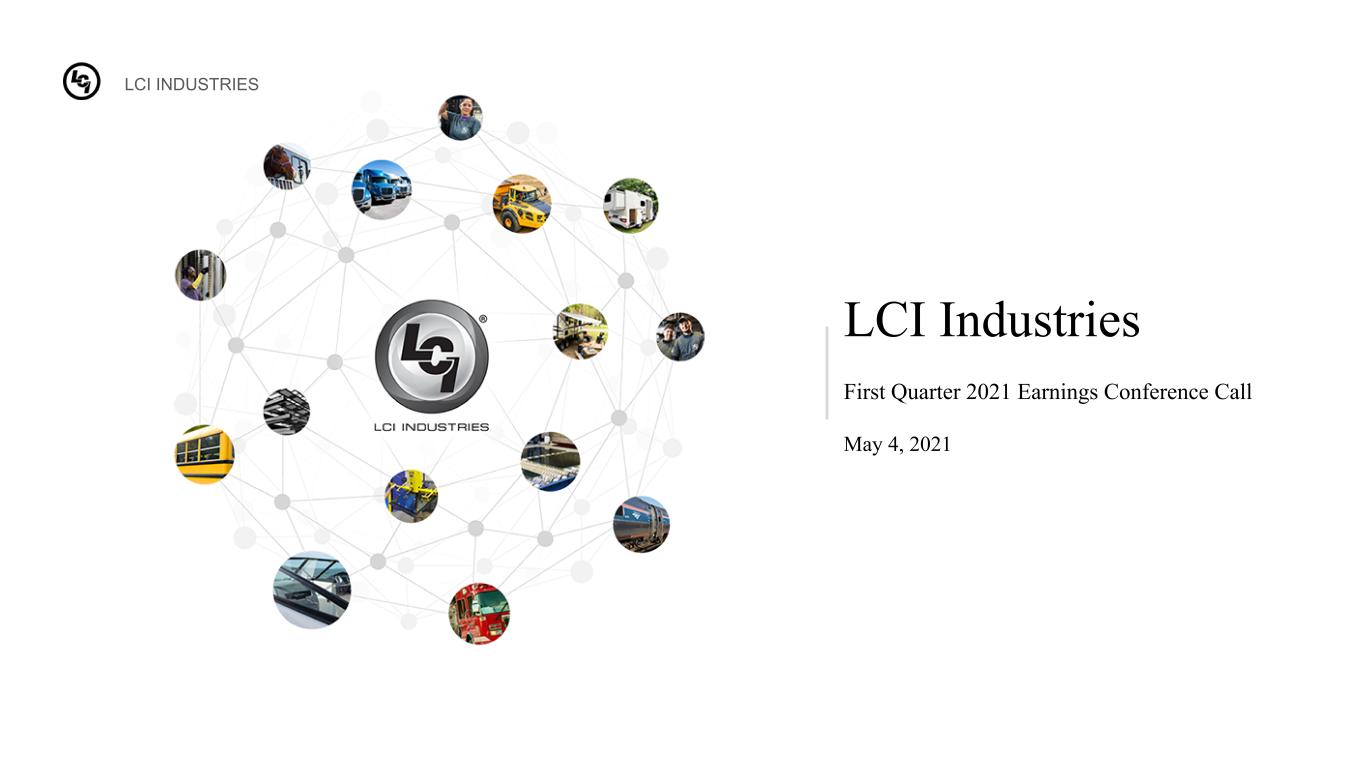
LCI INDUSTRIES 1 LCI Industries First Quarter 2021 Earnings Conference Call May 4, 2021
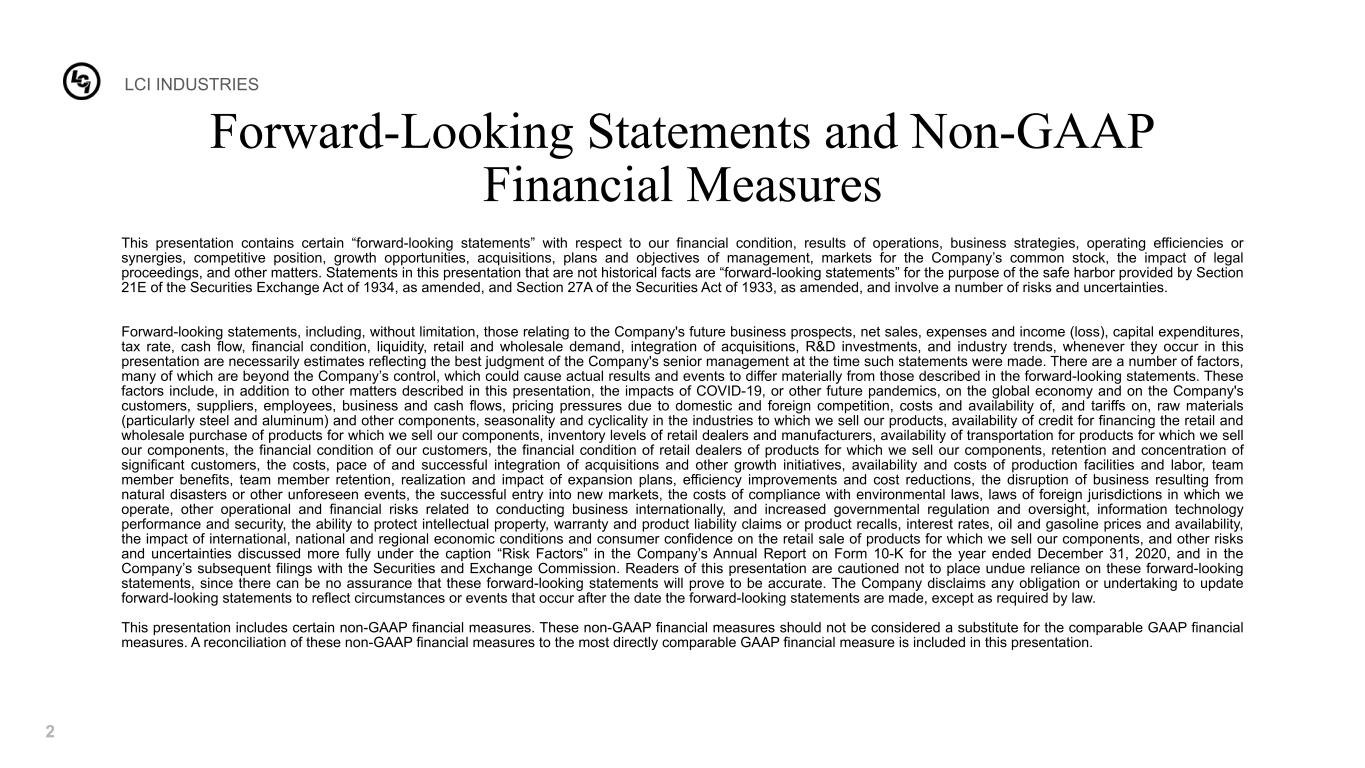
LCI INDUSTRIES 2 Forward-Looking Statements and Non-GAAP Financial Measures This presentation contains certain “forward-looking statements” with respect to our financial condition, results of operations, business strategies, operating efficiencies or synergies, competitive position, growth opportunities, acquisitions, plans and objectives of management, markets for the Company’s common stock, the impact of legal proceedings, and other matters. Statements in this presentation that are not historical facts are “forward-looking statements” for the purpose of the safe harbor provided by Section 21E of the Securities Exchange Act of 1934, as amended, and Section 27A of the Securities Act of 1933, as amended, and involve a number of risks and uncertainties. Forward-looking statements, including, without limitation, those relating to the Company's future business prospects, net sales, expenses and income (loss), capital expenditures, tax rate, cash flow, financial condition, liquidity, retail and wholesale demand, integration of acquisitions, R&D investments, and industry trends, whenever they occur in this presentation are necessarily estimates reflecting the best judgment of the Company's senior management at the time such statements were made. There are a number of factors, many of which are beyond the Company’s control, which could cause actual results and events to differ materially from those described in the forward-looking statements. These factors include, in addition to other matters described in this presentation, the impacts of COVID-19, or other future pandemics, on the global economy and on the Company's customers, suppliers, employees, business and cash flows, pricing pressures due to domestic and foreign competition, costs and availability of, and tariffs on, raw materials (particularly steel and aluminum) and other components, seasonality and cyclicality in the industries to which we sell our products, availability of credit for financing the retail and wholesale purchase of products for which we sell our components, inventory levels of retail dealers and manufacturers, availability of transportation for products for which we sell our components, the financial condition of our customers, the financial condition of retail dealers of products for which we sell our components, retention and concentration of significant customers, the costs, pace of and successful integration of acquisitions and other growth initiatives, availability and costs of production facilities and labor, team member benefits, team member retention, realization and impact of expansion plans, efficiency improvements and cost reductions, the disruption of business resulting from natural disasters or other unforeseen events, the successful entry into new markets, the costs of compliance with environmental laws, laws of foreign jurisdictions in which we operate, other operational and financial risks related to conducting business internationally, and increased governmental regulation and oversight, information technology performance and security, the ability to protect intellectual property, warranty and product liability claims or product recalls, interest rates, oil and gasoline prices and availability, the impact of international, national and regional economic conditions and consumer confidence on the retail sale of products for which we sell our components, and other risks and uncertainties discussed more fully under the caption “Risk Factors” in the Company’s Annual Report on Form 10-K for the year ended December 31, 2020, and in the Company’s subsequent filings with the Securities and Exchange Commission. Readers of this presentation are cautioned not to place undue reliance on these forward-looking statements, since there can be no assurance that these forward-looking statements will prove to be accurate. The Company disclaims any obligation or undertaking to update forward-looking statements to reflect circumstances or events that occur after the date the forward-looking statements are made, except as required by law. This presentation includes certain non-GAAP financial measures. These non-GAAP financial measures should not be considered a substitute for the comparable GAAP financial measures. A reconciliation of these non-GAAP financial measures to the most directly comparable GAAP financial measure is included in this presentation. 2

LCI INDUSTRIES 3 First Quarter 2021 Highlights Posted a record $1.0 billion in net sales during the first quarter, along with 68% growth in adjusted EBITDA Achieved double-digit growth across all markets, while significantly expanding market share and content per vehicle Completed two strategic acquisitions in April: Ranch Hand which further expands our presence in the ~$5 trillion truck accessory market, and Schaudt, an electronic control and energy management system supplier to the European caravan market, which establishes our presence in Germany Committed to expanding our production capabilities by executing additional projects, with 2 million square feet of additional capacity from recent and planned projects
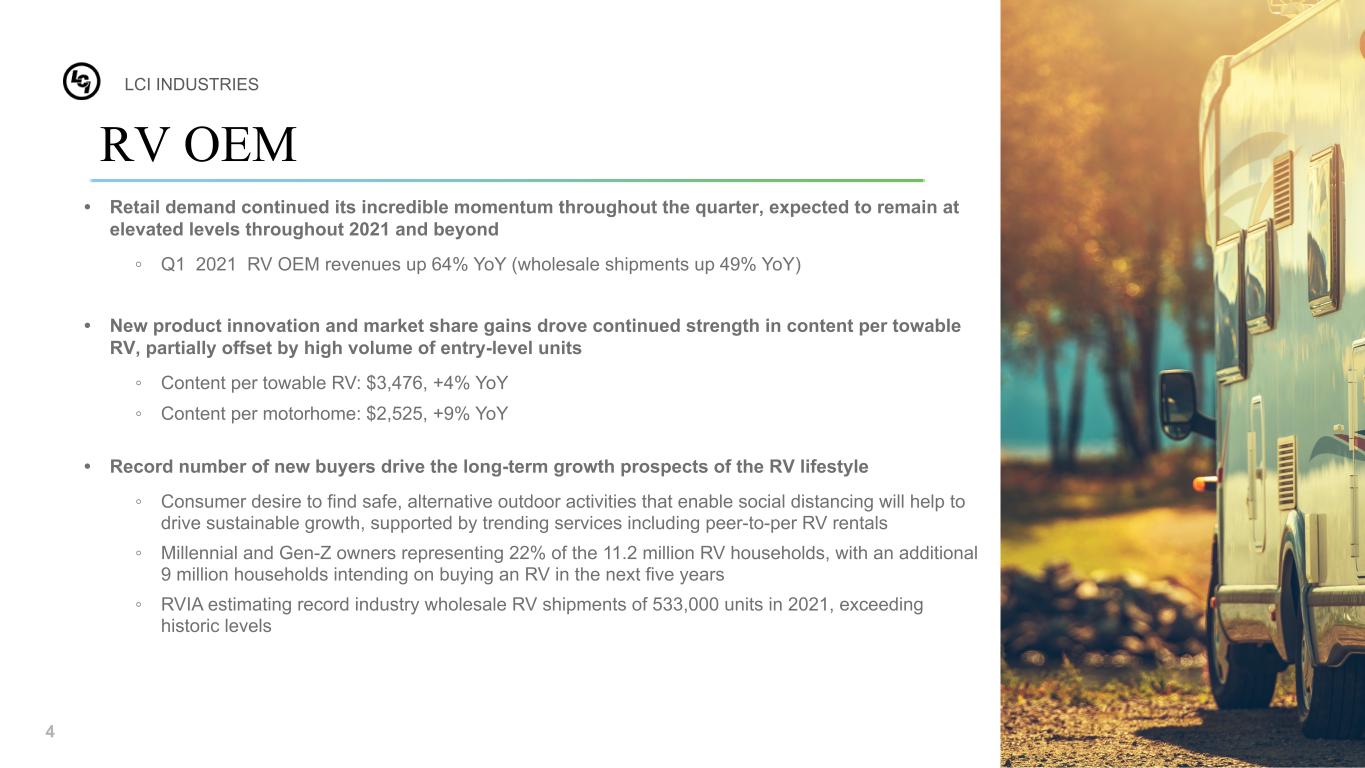
LCI INDUSTRIES 4 RV OEM • Retail demand continued its incredible momentum throughout the quarter, expected to remain at elevated levels throughout 2021 and beyond ◦ Q1 2021 RV OEM revenues up 64% YoY (wholesale shipments up 49% YoY) • New product innovation and market share gains drove continued strength in content per towable RV, partially offset by high volume of entry-level units ◦ Content per towable RV: $3,476, +4% YoY ◦ Content per motorhome: $2,525, +9% YoY • Record number of new buyers drive the long-term growth prospects of the RV lifestyle ◦ Consumer desire to find safe, alternative outdoor activities that enable social distancing will help to drive sustainable growth, supported by trending services including peer-to-per RV rentals ◦ Millennial and Gen-Z owners representing 22% of the 11.2 million RV households, with an additional 9 million households intending on buying an RV in the next five years ◦ RVIA estimating record industry wholesale RV shipments of 533,000 units in 2021, exceeding historic levels 4
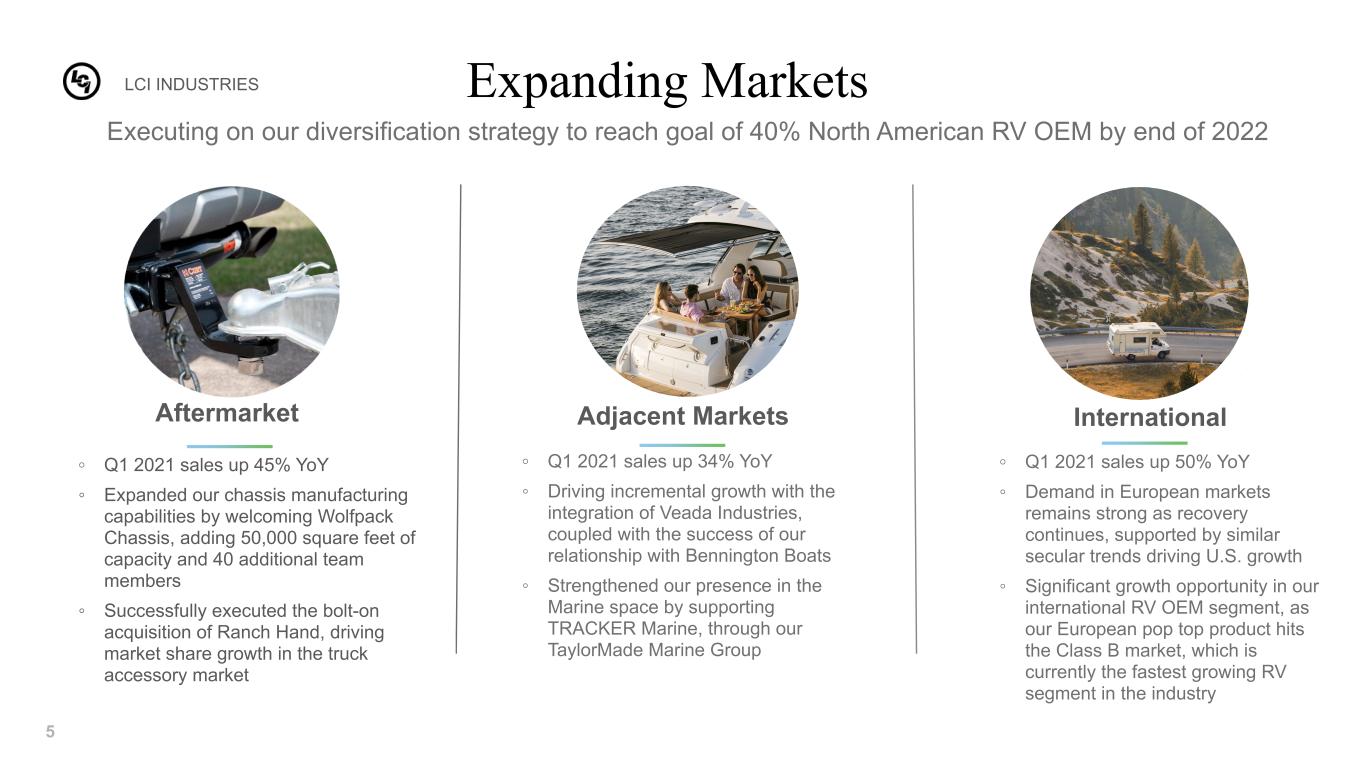
LCI INDUSTRIES 5 Expanding Markets Executing on our diversification strategy to reach goal of 40% North American RV OEM by end of 2022 Adjacent Markets Aftermarket International ◦ Q1 2021 sales up 45% YoY ◦ Expanded our chassis manufacturing capabilities by welcoming Wolfpack Chassis, adding 50,000 square feet of capacity and 40 additional team members ◦ Successfully executed the bolt-on acquisition of Ranch Hand, driving market share growth in the truck accessory market ◦ Q1 2021 sales up 34% YoY ◦ Driving incremental growth with the integration of Veada Industries, coupled with the success of our relationship with Bennington Boats ◦ Strengthened our presence in the Marine space by supporting TRACKER Marine, through our TaylorMade Marine Group ◦ Q1 2021 sales up 50% YoY ◦ Demand in European markets remains strong as recovery continues, supported by similar secular trends driving U.S. growth ◦ Significant growth opportunity in our international RV OEM segment, as our European pop top product hits the Class B market, which is currently the fastest growing RV segment in the industry 5
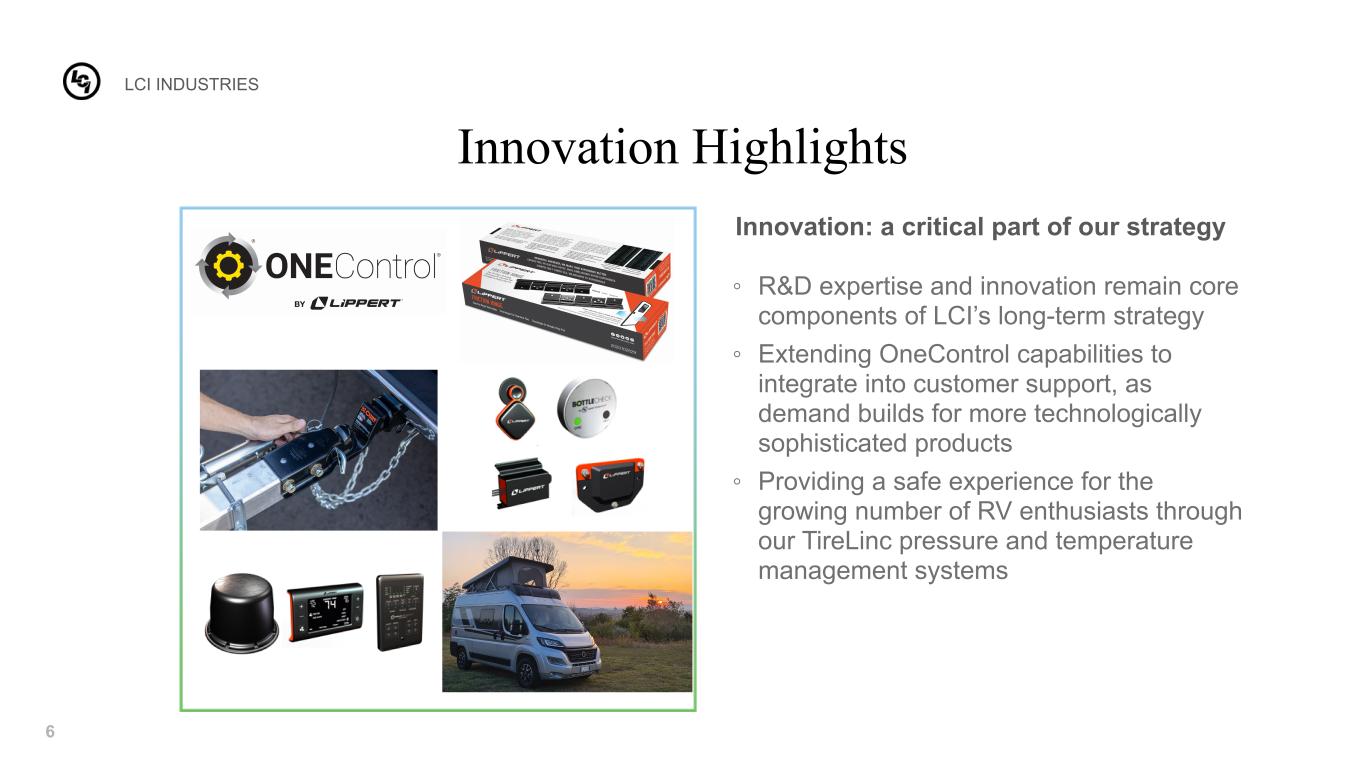
LCI INDUSTRIES 6 Innovation Highlights Innovation: a critical part of our strategy ◦ R&D expertise and innovation remain core components of LCI’s long-term strategy ◦ Extending OneControl capabilities to integrate into customer support, as demand builds for more technologically sophisticated products ◦ Providing a safe experience for the growing number of RV enthusiasts through our TireLinc pressure and temperature management systems 6

LCI INDUSTRIES 7 Growth Strategy Integrating and Realizing Synergies from New Acquisitions ◦ LCI remains focused on realizing new synergies from our most recent acquisitions, preserving cash, and paying down debt in the near-term ◦ Maintaining a robust pipeline of M&A targets split evenly across all market segments and are open to small and strategic tuck-in acquisitions Capitalizing on Ability to Win Market Share ◦ Growing market leadership in adjacent markets, international markets, and the aftermarket segment through enhanced engineering and innovation Continued Focus on Stated Capital Allocation Goals ◦ Investment in the business ◦ Reduce leverage ◦ Return capital to shareholders ◦ Execute strategic acquisitions 7
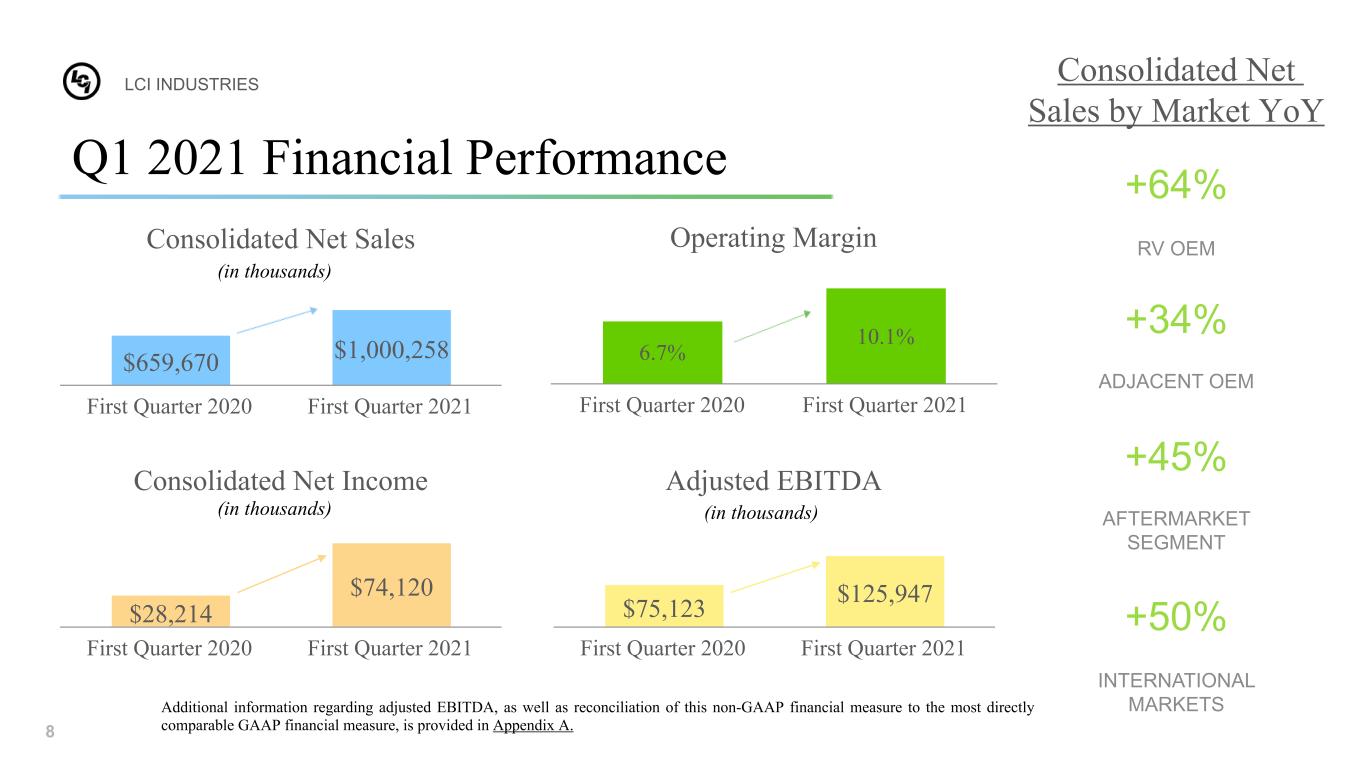
LCI INDUSTRIES 8 Consolidated Net Sales $659,670 $1,000,258 First Quarter 2020 First Quarter 2021 Operating Margin 6.7% 10.1% First Quarter 2020 First Quarter 2021 Q1 2021 Financial Performance Consolidated Net Sales by Market YoY (in thousands) +64% RV OEM +34% ADJACENT OEM +45% AFTERMARKET SEGMENT +50% INTERNATIONAL MARKETS Consolidated Net Income $28,214 $74,120 First Quarter 2020 First Quarter 2021 (in thousands) Adjusted EBITDA $75,123 $125,947 First Quarter 2020 First Quarter 2021 (in thousands) Additional information regarding adjusted EBITDA, as well as reconciliation of this non-GAAP financial measure to the most directly comparable GAAP financial measure, is provided in Appendix A.8
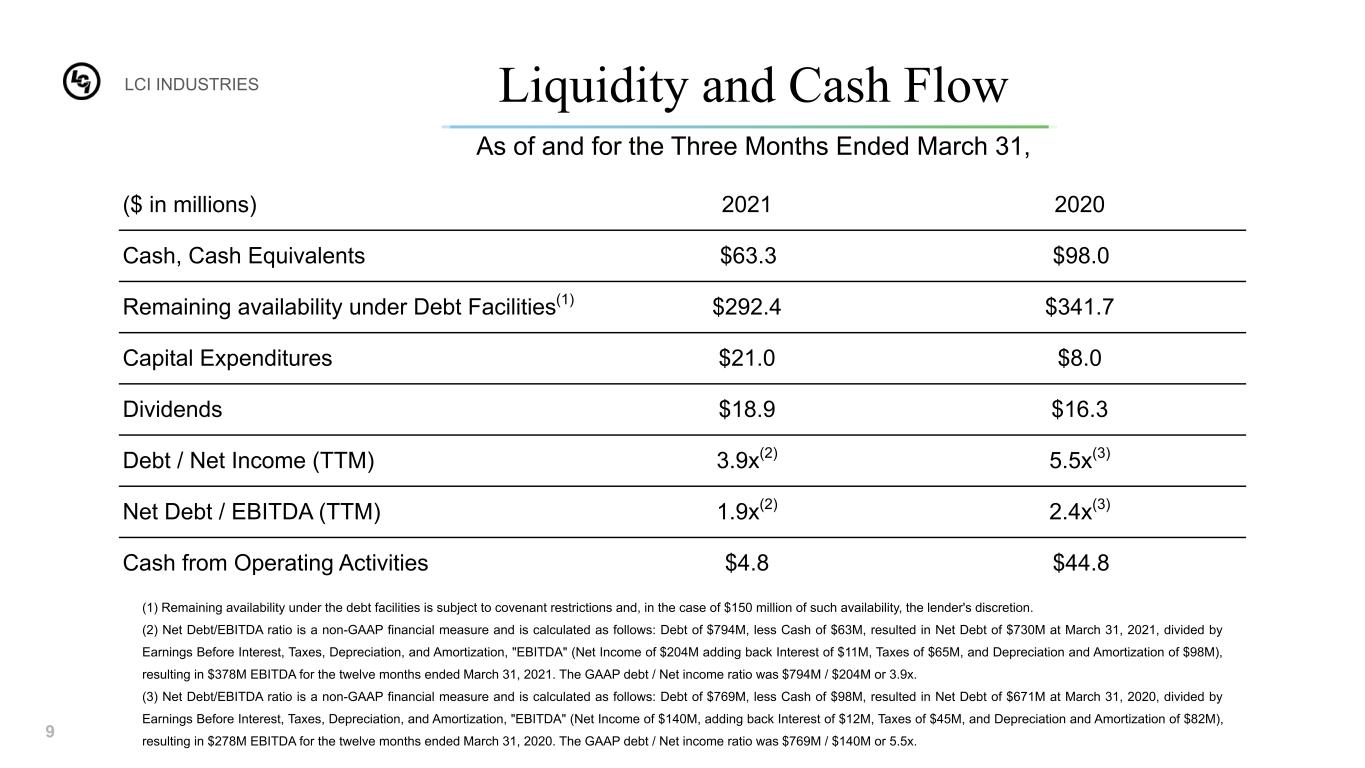
LCI INDUSTRIES 9 ($ in millions) 2021 2020 Cash, Cash Equivalents $63.3 $98.0 Remaining availability under Debt Facilities(1) $292.4 $341.7 Capital Expenditures $21.0 $8.0 Dividends $18.9 $16.3 Debt / Net Income (TTM) 3.9x(2) 5.5x(3) Net Debt / EBITDA (TTM) 1.9x(2) 2.4x(3) Cash from Operating Activities $4.8 $44.8 (1) Remaining availability under the debt facilities is subject to covenant restrictions and, in the case of $150 million of such availability, the lender's discretion. (2) Net Debt/EBITDA ratio is a non-GAAP financial measure and is calculated as follows: Debt of $794M, less Cash of $63M, resulted in Net Debt of $730M at March 31, 2021, divided by Earnings Before Interest, Taxes, Depreciation, and Amortization, "EBITDA" (Net Income of $204M adding back Interest of $11M, Taxes of $65M, and Depreciation and Amortization of $98M), resulting in $378M EBITDA for the twelve months ended March 31, 2021. The GAAP debt / Net income ratio was $794M / $204M or 3.9x. (3) Net Debt/EBITDA ratio is a non-GAAP financial measure and is calculated as follows: Debt of $769M, less Cash of $98M, resulted in Net Debt of $671M at March 31, 2020, divided by Earnings Before Interest, Taxes, Depreciation, and Amortization, "EBITDA" (Net Income of $140M, adding back Interest of $12M, Taxes of $45M, and Depreciation and Amortization of $82M), resulting in $278M EBITDA for the twelve months ended March 31, 2020. The GAAP debt / Net income ratio was $769M / $140M or 5.5x. Liquidity and Cash Flow As of and for the Three Months Ended March 31, 9
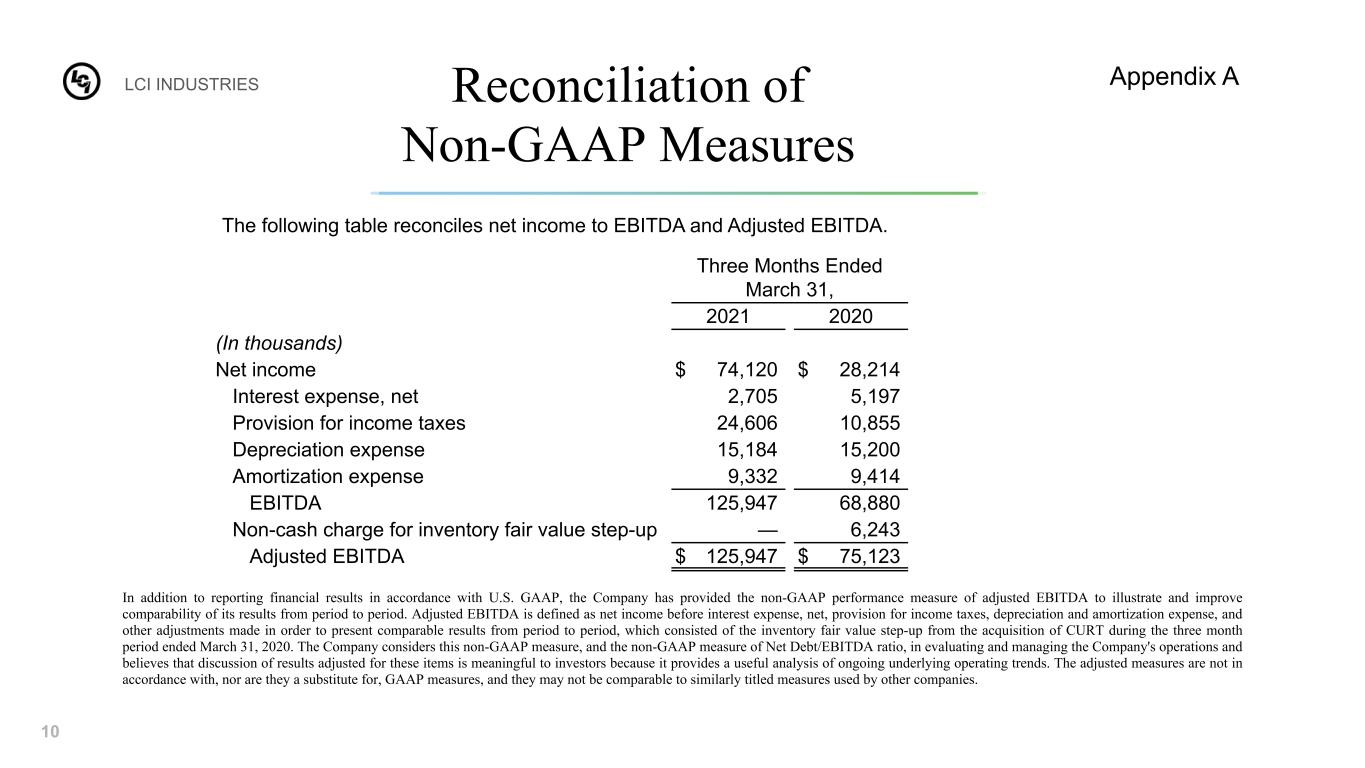
LCI INDUSTRIES 10 Reconciliation of Non-GAAP Measures The following table reconciles net income to EBITDA and Adjusted EBITDA. Three Months Ended March 31, 2021 2020 (In thousands) Net income $ 74,120 $ 28,214 Interest expense, net 2,705 5,197 Provision for income taxes 24,606 10,855 Depreciation expense 15,184 15,200 Amortization expense 9,332 9,414 EBITDA 125,947 68,880 Non-cash charge for inventory fair value step-up — 6,243 Adjusted EBITDA $ 125,947 $ 75,123 In addition to reporting financial results in accordance with U.S. GAAP, the Company has provided the non-GAAP performance measure of adjusted EBITDA to illustrate and improve comparability of its results from period to period. Adjusted EBITDA is defined as net income before interest expense, net, provision for income taxes, depreciation and amortization expense, and other adjustments made in order to present comparable results from period to period, which consisted of the inventory fair value step-up from the acquisition of CURT during the three month period ended March 31, 2020. The Company considers this non-GAAP measure, and the non-GAAP measure of Net Debt/EBITDA ratio, in evaluating and managing the Company's operations and believes that discussion of results adjusted for these items is meaningful to investors because it provides a useful analysis of ongoing underlying operating trends. The adjusted measures are not in accordance with, nor are they a substitute for, GAAP measures, and they may not be comparable to similarly titled measures used by other companies. Appendix A 10

Q&A L C I I N D U S T R I E S
